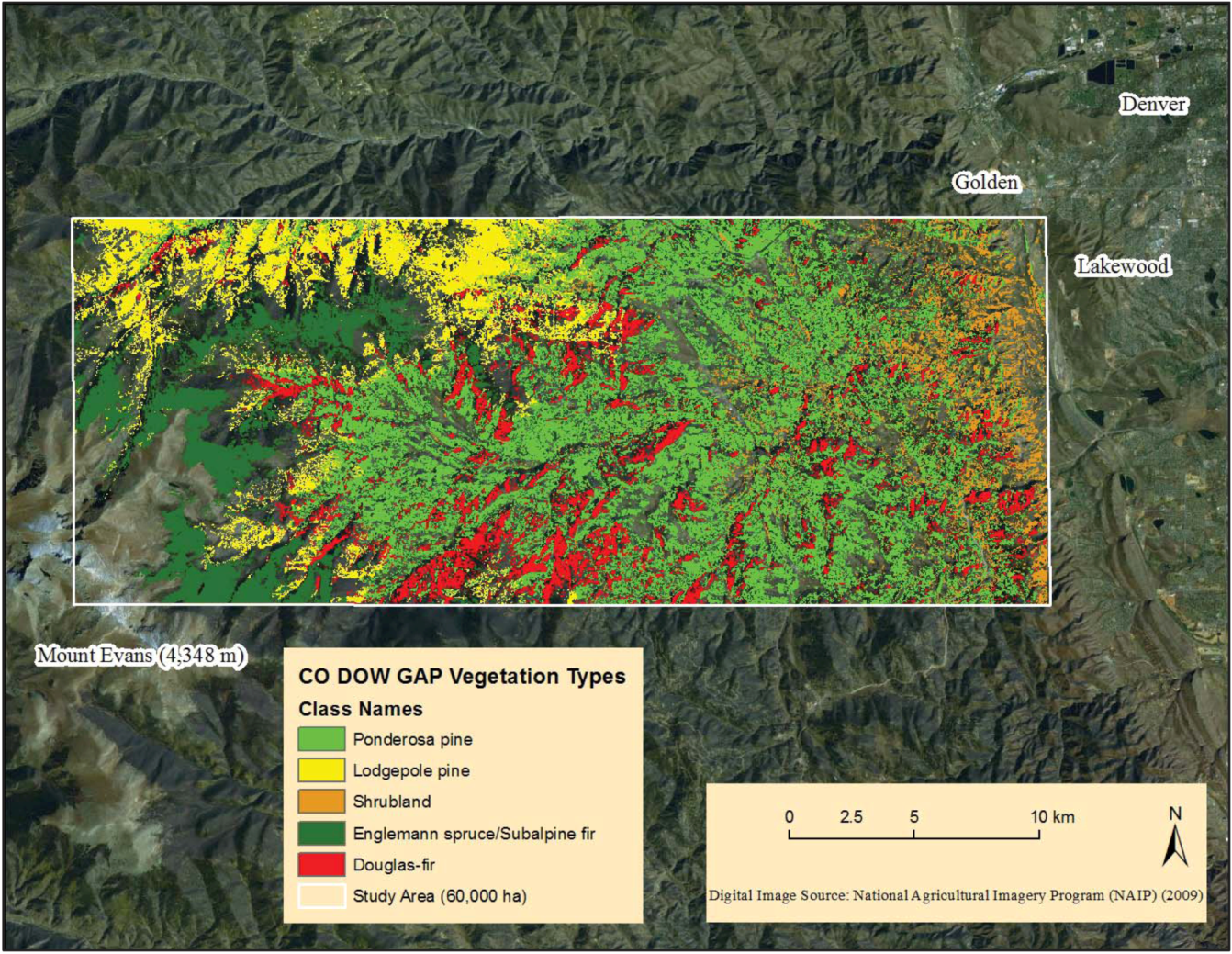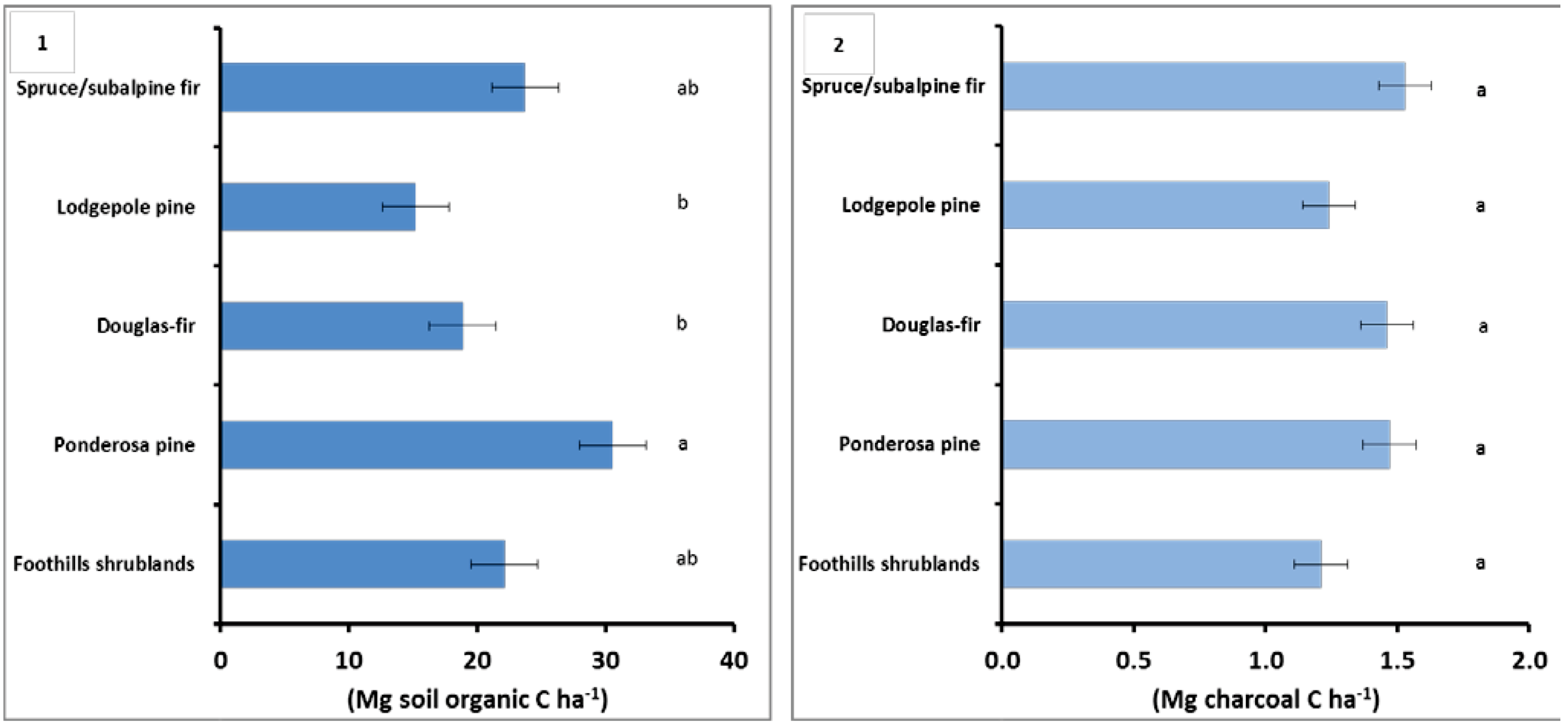Charcoal and Total Carbon in Soils from Foothills Shrublands to Subalpine Forests in the Colorado Front Range
Abstract
:1. Introduction
2. Materials and Methods
2.1. Experimental Design and Field Sampling

2.2. Laboratory Methods
2.3. Statistical Analysis
3. Results
| Vegetation Type | SOC (g kg−1) | CC (g kg−1) | BDa (g cm−3) | SOC (mg ha−1) | CC (mg ha−1) | CC/SOCb |
|---|---|---|---|---|---|---|
| (sampling elevation) | ||||||
| Foothills shrublands | 19.1 (0.8) | 1.1 (0.1) | 1.16 | 22.1 (1.0) | 1.2 (0.1) | 0.05a |
| (1700–1900 m) | ||||||
| Ponderosa pine | 23.3 (1.4) | 1.1 (0.1) | 1.31 | 30.5 (1.9) | 1.5 (0.1) | 0.06ab |
| (1900–2100 m) | ||||||
| Douglas-fir | 14.6 (0.8) | 1.1 (0.1) | 1.29 | 18.8 (1.0) | 1.5 (0.1) | 0.08ab |
| (2400–2600 m) | ||||||
| Lodgepole pine | 15.0 (0.8) | 1.2 (0.1) | 1.01 | 15.2 (0.8) | 1.2 (0.1) | 0.08b |
| (2800–3000 m) | ||||||
| Spruce/subalpine fir | 21.8 (1.1) | 1.4 (0.1) | 1.09 | 23.7 (1.2) | 1.5 (0.1) | 0.07ab |
| (3200–3400 m) |

4. Discussion
| Vegetation Type | CC Source a | Fire Regime b | Soil Process c |
|---|---|---|---|
| Foothills shrublands |
|
|
|
| Ponderosa pine |
|
|
|
| Douglas-fir |
|
|
|
| Lodgepole pine |
|
|
|
| Spruce/subalpine fir |
|
|
|
5. Conclusions
Conflict of Interest
Acknowledgements
References
- Nocentini, C.; Certini, G.; Knicker, H.; Francioso, O.; Rumpel, C. Nature and reactivity of charcoal produced and added to soil during wildfire are particle-size dependent. Org. Geochem. 2010, 41, 682–689. [Google Scholar] [CrossRef]
- Preston, C.M.; Schmidt, M.W.I. Black (pyrogenic) carbon: A synthesis of current knowledge and uncertainties with special consideration of boreal regions. Bio. Geo. Sciences 2006, 3, 397–420. [Google Scholar]
- Czimczik, C.I.; Masiello, C.A. Controls on black carbon storage in soils. Global Biogeochem. Cy. 2007, 21, GB3005. [Google Scholar] [CrossRef]
- MacKenzie, M.D.; McIntire, E.J.B.; Quideau, S.A.; Graham, R.C. Charcoal distribution affects carbon and nitrogen contents in forest soils of California. Soil Sci. Soc. Am. J. 2008, 72, 1774–1785. [Google Scholar] [CrossRef]
- DeLuca, T.H.; MacKenzie, M.D.; Gundale, M.J.; Holben, W.E. Wildfire-produced charcoal directly influences nitrogen cycling in ponderosa pine forests. Soil Sci. Soc. Am. J. 2006, 70, 448–453. [Google Scholar] [CrossRef]
- Ball, P.N.; MacKenzie, M.D.; DeLuca, T.H.; Holben, W.E. Wildfire and charcoal enhance nitrification and ammonium-oxidizing bacterial abundance in dry montane forest soils. J. Environ. Qual. 2010, 39, 1243–1253. [Google Scholar] [CrossRef]
- Gundale, M.J.; DeLuca, T.H. Temperature and source material influence ecological attributes of ponderosa pine and Douglas-fir charcoal. For. Ecol. Manag. 2006, 231, 86–93. [Google Scholar] [CrossRef]
- Johnson, E.A.; Miyanishi, K. Forest Fires: Behavior and Ecological Effects; Academic Press: San Diego, CA, USA, 2001. [Google Scholar]
- Forbes, M.S.; Raison, R.J.; Skjemstad, J.O. Formation, transformation and transport of black carbon (charcoal) in terrestrial and aquatic ecosystems. Sci. Total Environ. 2006, 370, 190–206. [Google Scholar] [CrossRef]
- Tinker, D.B.; Knight, D.H. Coarse woody debris following fire and logging in Wyoming lodgepole pine forests. Ecosystems 2000, 3, 472–483. [Google Scholar] [CrossRef]
- Knicker, H. How does fire affect the nature and stability of soil organic nitrogen and carbon? A review. Biogeochemistry 2007, 85, 91–118. [Google Scholar] [CrossRef]
- Kane, E.S.; Hockaday, W.C.; Turetsky, M.R.; Masiello, C.A.; Valentine, D.W.; Finney, B.P.; Baldock, J.A. Topographic controls on black carbon accumulation in Alaskan black spruce forest soils: Implications for organic matter dynamics. Biogeochemistry 2010, 100, 39–56. [Google Scholar] [CrossRef]
- DeLuca, T.H.; Aplet, G.H. Charcoal and carbon storage in forest soils of the Rocky Mountain west. Front. Ecol. Environ. 2008, 6, 18–24. [Google Scholar] [CrossRef]
- Miller, C. Simulation of effects of climatic change on fire regimes. In Fire and Climatic Change in Temperate Ecosystems of the Western Americas; Veblen, T.T., Baker, W.L., Montenegro, G., Swetnam, T.W., Eds.; Springer: New York, NY, USA, 2003; pp. 69–94. [Google Scholar]
- Cochrane, M.A.; Ryan, K.C. Fire and fire ecology: Concepts and principles. In Tropical Fire Ecology: Climate Change, Land Use and Ecosystem Dynamics; Cochrane, M.A, Ed.; Springer-Praxis: Heidelberg, Germany, 2009; pp. 25–62. [Google Scholar]
- Baker, W.L. Fires and climate in forested landscapes of the U.S. Rocky Mountains. In Fire and Climatic Change in Temperate Ecosystems of the Western Americas; Veblen, T.T., Baker, W.L., Montenegro, G., Swetnam, T.W., Eds.; Springer: New York, NY, USA, 2003; pp. 120–157. [Google Scholar]
- Sibold, J.S.; Veblen, T.T. Relationships of subalpine forest fires in the Colorado Front Range with interannual and multidecadal-scale climatic variation. J. Biogeogr. 2006, 33, 833–842. [Google Scholar] [CrossRef]
- Bowman, D.M. Fire Ecology. Prog. Phys. Geog. 2007, 31, 523–532. [Google Scholar]
- Romme, W.H.; Veblen, T.T.; Kaufmann, M.R.; Sherriff, R.; Regan, C.M. Ecological Effects of the Hayman Fire—Part 1: Historical (Pre-1860) and Current (1860–2002) Fire Regimes. In Hayman Fire Case Study Analysis; Graham, R.T., Ed.; USDA Forest Service: Ogden, UT, USA, 2003; pp. 181–195. [Google Scholar]
- Kurth, V.J.; MacKenzie, M.D.; DeLuca, T.H. Estimating charcoal content in forest mineral soils. Geoderma. 2006, 137, 135–139. [Google Scholar] [CrossRef]
- Peet, R.K. Forest vegetation of the Colorado Front Range-Composition and dynamics. Plant Ecol. 1981, 45, 3–75. [Google Scholar]
- Birkeland, P.W.; Shroba, R.R.; Burns, S.F.; Price, A.B.; Tonkin, P.J. Integrating soils and geomorphology in mountains—An example from the Front Range of Colorado. Geomorphology 2003, 55, 329–344. [Google Scholar] [CrossRef]
- United States Geological Survey (USGS) National GAP Analysis Program. Available online: http://gapanalysis.usgs.gov (accessed on 1 June 2011).
- United States Department of Agriculture (USDA) Geospatial Data Gateway. Available online: http://datagateway.nrcs.usda.gov (accessed on 1 June 2011).
- McCulloch, C.E.; Searle, S.R.; Neuhaus, J.M. Generalized, Linear and Mixed Models; Wiley: New York, NY, USA, 2008. [Google Scholar]
- Wampold, B.E.; Serlin, R.C. The consequence of ignoring a nested factor on measures of effect size in analysis of variance. Psychol. Methods 2000, 5, 425–433. [Google Scholar] [CrossRef]
- Carcaillet, C.; Talon, B. Soil carbon sequestration by Holocene fires inferred from soil charcoal in the dry French Alps. Arct. Antarct. Alp. Res. 2001, 33, 282–288. [Google Scholar]
- Shindo, H.; Honna, T.; Yamamoto, S.; Honma, H. Contribution of charred plant fragments to soil organic carbon in Japanese volcanic ash soils containing black humic acids. Org. Geochem. 2004, 35, 235–241. [Google Scholar] [CrossRef]
- Eckmeier, E.; Egli, M.; Schmidt, M.W.I.; Schlumpf, N.; Noetzli, M.; Minikus-Stary, N.; Hagedorn, F. Preservation of fire-derived carbon compounds and sorptive stabilisation promote the accumulation of organic matter in black soils of the southern Alps. Geoderma. 2010, 159, 147–155. [Google Scholar] [CrossRef] [Green Version]
- Brodowski, S.; Amelung, W.; Haumaier, L.; Zech, W. Black carbon contribution to stable humus in German arable soils. Geoderma. 2007, 139, 220–228. [Google Scholar] [CrossRef]
- Veblen, T.T.; Donnegan, J.A. Historical Range of Variability for Forest Vegetation of the National Forests of the Colorado Front Range; USDA Forest Service, Rocky Mountain Region; Colorado Forest Restoration Institute, Warner College of Natural Resources, Colorado State University: Fort Collins, CO, USA, 2006. [Google Scholar]
- Zhang, D.; Hui, D.; Luo, Y.; Zhou, G. Rates of litter decomposition in terrestrial ecosystems: Global patterns and controlling factors. J. Plant. Ecol. 2008, 1, 85–93. [Google Scholar] [CrossRef]
- Hammes, K.; Schmidt, M.W.I.; Smernik, R.J.; Currie, L.A.; Ball, W.P.; Nguyen, T.H.; Louchouarn, P.; Houel, S.; Gustafsson, Ö.; Elmquist, M.; et al. Comparison of quantification methods to measure fire-derived (black/elemental) carbon in soils and sediments using reference materials from soil, water, sediment and the atmosphere. Global Biogeochem. Cy. 2007, 21, GB3016. [Google Scholar] [CrossRef]
- Brodowski, S.; Rodionov, A.; Haumaier, L.; Glaser, B.; Amelung, W. Revised black carbon assessment using benzene polycarboxylic acids. Org. Geochem. 2005, 36, 1299–1310. [Google Scholar] [CrossRef]
- Hammes, K.; Smernik, R.J.; Skjemstad, J.O.; Schmidt, M.W.I. Characterisation and evaluation of reference materials for black carbon analysis using elemental composition, colour, BET surface area and C-13 NMR spectroscopy. Appl. Geochem. 2008, 23, 2113–2122. [Google Scholar] [CrossRef]
- Scott, A.C.; Damblon, F. Charcoal: Taphonomy and significance in geology, botany and archaeology. Palaeogeogr. Palaeoclimatol. Palaeoecol. 2010, 291, 1–10. [Google Scholar] [CrossRef]
- Touflan, P.P.; Talon, B. Spatial reliability of soil charcoal analysis: The case of subalpine forest soils. Ecoscience 2009, 16, 23–27. [Google Scholar] [CrossRef]
- Fesenmyer, K.A.; Christensen, N.L., Jr. Reconstructing Holocene fire history in a southern Appalachian forest using soil charcoal. Ecology 2010, 91, 662–670. [Google Scholar] [CrossRef]
- Westerling, A.L.; Turner, M.G.; Smithwick, E.A.H.; Romme, W.H.; Ryan, M.G. Continued warming could transform greater Yellowstone fire regimes by mid-21st century. Proc. Natl. Acad. Sci. USA 2011, 108, 13165–13170. [Google Scholar]
- Adger, W.N.; Aggarwal, P.; Agrawala, S.; Alcamo, J. Summary for policy-makers. In Climate Change 2007: Impacts, Adaptation and Vulnerability; Contribution of Working Group II to the Fourth Assessment Report of the Intergovernmental Panel on Climate Change; Cambridge University Press: Cambridge, UK, 2007; pp. 7–22. [Google Scholar]
- Millar, C.I.; Stephenson, N.L.; Stephens, S.L. Climate change and forests of the future: Managing in the face of uncertainty. Ecol. Appl. 2007, 17, 2145–2151. [Google Scholar] [CrossRef]
© 2012 by the authors; licensee MDPI, Basel, Switzerland. This article is an open-access article distributed under the terms and conditions of the Creative Commons Attribution license (http://creativecommons.org/licenses/by/3.0/).
Share and Cite
Licata, C.; Sanford, R. Charcoal and Total Carbon in Soils from Foothills Shrublands to Subalpine Forests in the Colorado Front Range. Forests 2012, 3, 944-958. https://doi.org/10.3390/f3040944
Licata C, Sanford R. Charcoal and Total Carbon in Soils from Foothills Shrublands to Subalpine Forests in the Colorado Front Range. Forests. 2012; 3(4):944-958. https://doi.org/10.3390/f3040944
Chicago/Turabian StyleLicata, Christopher, and Robert Sanford. 2012. "Charcoal and Total Carbon in Soils from Foothills Shrublands to Subalpine Forests in the Colorado Front Range" Forests 3, no. 4: 944-958. https://doi.org/10.3390/f3040944




